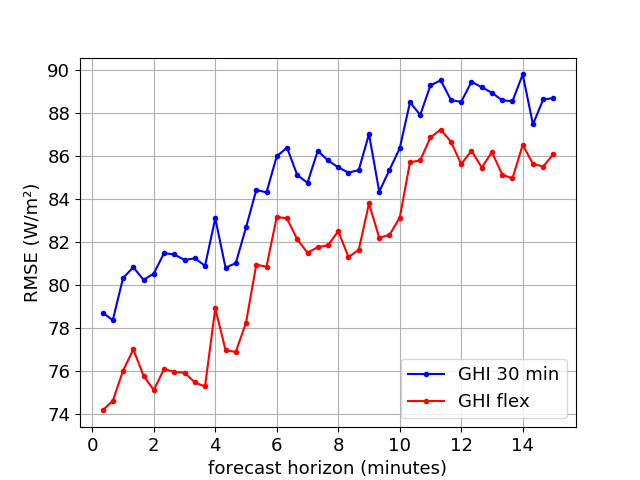6th International Conference Energy & Meteorology: Abstract Submission
Irradiance models in sky imager forecasting (682)
Objective & Background
High resolution irradiance forecasts based on sky imagers are valuable for applications that require short term decisions based on ramps of solar irradiance. For example, local consumers like heat pumps with a minimum run time of several minutes can be controlled using short term forecasts in order to optimize the self-consumption of a rooftop PV system.
Sky imager based forecasting algorithms often assign a binary cloud decision to each pixel [1]. In the next step, this binary information is translated to solar irradiance. A simple method for irradiance retrieval is based on a histogram of the clear sky index from recent measurements of global horizontal irradiance (GHI) [2]. More advanced methods calculate the direct normal and the diffuse horizontal irradiance (DNI, DHI) separately based on image information or measurements [1] [3].
Here we compare and optimize different approaches to derive irradiance forecasts from a sky imager. In particular, we investigate the influence of the time range of recent measurements used for the irradiance retrieval and introduce a flexible time range, depending on the weather situation.
Method
We have implemented a sky imager based forecasting model using a standard surveillance camera in Freiburg, Germany. At the site of the camera GHI as well as DHI and DNI are measured. In a first experiment to compare irradiance retrieval methods, a binary “perfect cloud decision forecast” was generated from measurements, using a clear sky index threshold derived from measured GHI to distinguish between cloudy and sunny conditions. In this way, we aim to investigate the performance of the irradiance algorithms independent of errors in sky imager based cloud decision and motion estimation. In a second step, we will evaluate the best approaches using “real” irradiance forecasts generated with our sky imager forecasting model. 46 days from summer/ autumn 2018 covering different weather situations were selected as a test dataset.
We analyse methods using only GHI in comparison to methods using DHI and DNI. In order to optimize our results we test a weather dependent time range for the irradiance retrieval.
Principal Findings
First results show that a flexible time range of up to two hours reduces the root mean square error (RMSE) for all forecast steps compared to a fixed time range of 30 min (Fig 1) for the “perfect cloud decision forecast”. The Skill (i.e. relative improvement over persistence) is around 40-50%.

Fig 1: RMSE of an irradiance forecast based on a “perfect cloud decision forecast”. The time range used for the histogram is 30 min or flexible. Time resolution is 20s (instantaneous values)
Conclusion
The findings indicate the potential for improving sky imager irradiance forecasts by optimizing the input to the irradiance model. For the final presentation we will compare these results to a method using DHI and DNI measurements, and potentially also image information. Based on this analysis we will propose an optimized algorithm for irradiance retrieval from sky imagers and discuss the limits of a binary cloud decision algorithm.
- Schmidt, T. (2017): High resolution solar irradiance forecasts based on skyimages. PhD dissertation, Oldenburg University.
- Yang, H.; Kurtz, B.; Nguyen, D.; Urquhart, B.; Chow, C. W.; Ghonima, M.; Kleissl, J. (2014): Solar irradiance forecasting using a ground-based sky imager developed at UC San Diego. In: Solar Energy 103, S. 502–524.
- Kurtz, B.; Kleissl, J. (2017): Measuring diffuse, direct, and global irradiance using a sky imager. In: Solar Energy 141, S. 311–322.